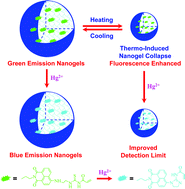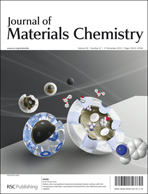We report on the fabrication of thermoresponsive poly(N-isopropylacrylamide) nanogel-based dual fluorescent sensors for temperature and Hg2+ ions, and the effects of thermo-induced nanogel collapse on the detection sensitivity of Hg2+ ions. Near-monodisperse thermoresponsive nanogels were prepared via emulsion polymerization of N-isopropylacrylamide (NIPAM) and a novel 1,8-naphthalimide-based polarity-sensitive and Hg2+-reactive fluorescent monomer (NPTUA, 3). At room temperature, PNIPAM nanogels labeled with a single type of naphthalimide-based dye (NPTUA) can act as ratiometric Hg2+ probes at the nanomolar level. Upon heating above the phase transition temperature, the fluorescence intensity of NPTUA-labeled nanogels in the absence of Hg2+ exhibit ∼3.4-fold increase due to that NPTUA moieties are now located in a more hydrophobic microenvironment. Moreover, it was observed that the detection sensitivity to Hg2+ can be further improved above the nanogel phase transition temperature. At a nanogel concentration of 0.05 g L−1 and in the same Hg2+ concentration range (0–3.0 equiv.), ∼10 fold and ∼57 fold increase in fluorescence emission intensity ratio changes can be achieved at 25 and 40 °C, respectively.

You have access to this article
 Please wait while we load your content...
Something went wrong. Try again?
Please wait while we load your content...
Something went wrong. Try again?


 Please wait while we load your content...
Please wait while we load your content...